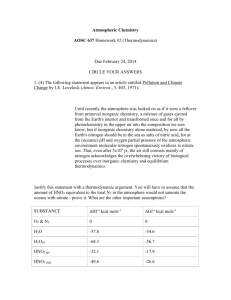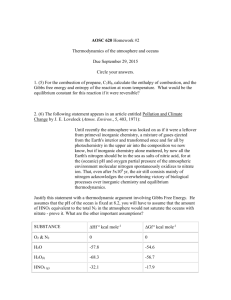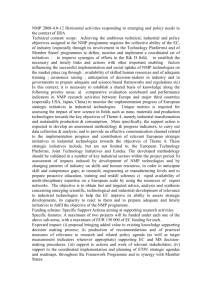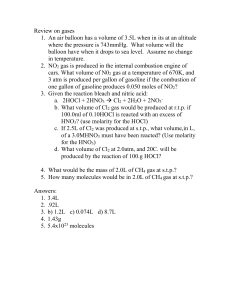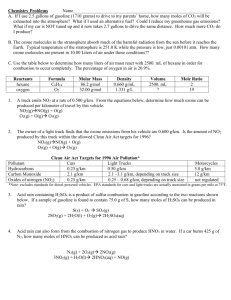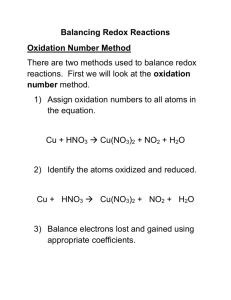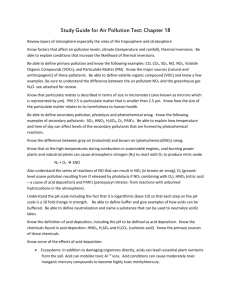Chemistry of Inorganic Nitrogen Compounds Outline
advertisement
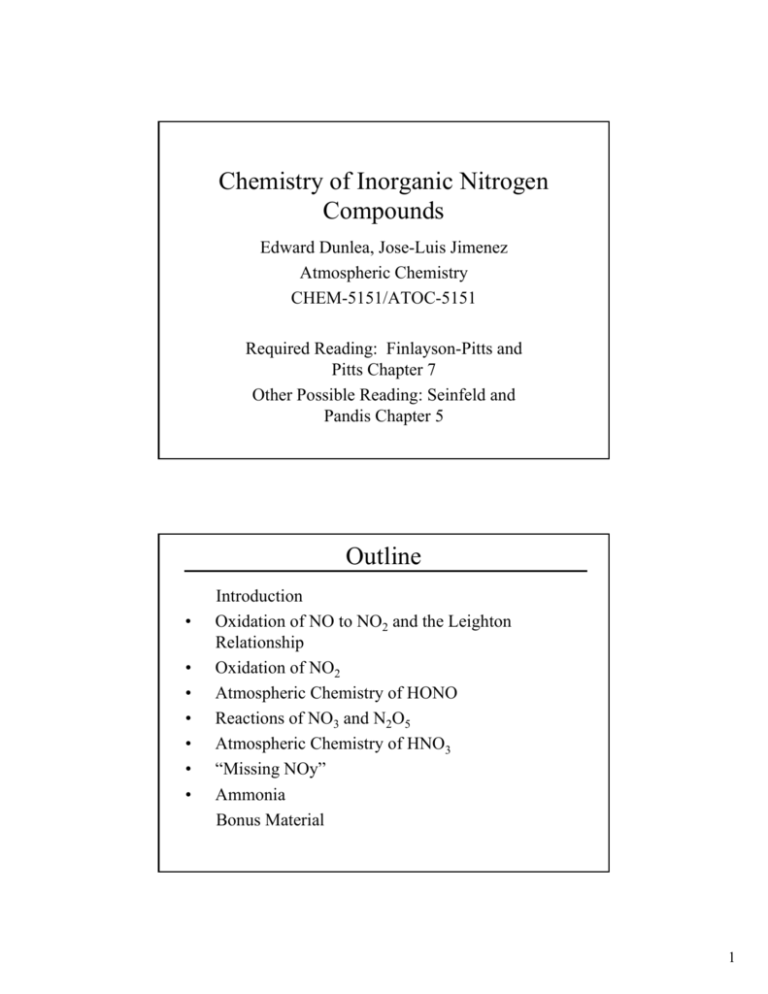
Chemistry of Inorganic Nitrogen
Compounds
Edward Dunlea, Jose-Luis Jimenez
Atmospheric Chemistry
CHEM-5151/ATOC-5151
Required Reading: Finlayson-Pitts and
Pitts Chapter 7
Other Possible Reading: Seinfeld and
Pandis Chapter 5
Outline
•
•
•
•
•
•
•
Introduction
Oxidation of NO to NO2 and the Leighton
Relationship
Oxidation of NO2
Atmospheric Chemistry of HONO
Reactions of NO3 and N2O5
Atmospheric Chemistry of HNO3
“Missing NOy”
Ammonia
Bonus Material
1
Motivation
• Inorganic nitrate compounds intimately
involved in important chemical processes in
both troposphere and stratosphere
– NO2 is key to formation of tropospheric ozone
• Both in polluted and background troposphere
– HNO3 key ingredient in acid rain
– NO3 is primary night time oxidant
– Participate with halogens in O3 destruction
chemistry in stratosphere
• Regulate chain length of O3-destroying reactions
• Fascinating chemistry + unresolved issues
Intro
Diagram of NOy
• Stable species in
circles
• Major pathways
denoted by arrows
• Will use this
diagram throughout
Intro
2
Definitions
• NOx = NO + NO2
– These are the key nitrogen containing species
– Rapid interconversion between NO & NO2 in
stratosphere and troposphere
• NOy = NO + NO2 + HNO3 + PAN + HONO +
NO3 + 2N2O5 + organic nitrates (RNO3) +
particulate nitrate (pNO3-) + …
– NOx + all of its reservoir species
• NOz = NOy – NOx
– Just the reservoir species
Intro
Breaking Down NOy
• NOx = NO + NO2
– Rapid
interconversion
• NOy = NOx +
reservoir species
• NOz = reservoir
species
Intro
3
Sources and Sinks
• Sources of NOy
primarily directly
emitted NO + NO2
– Combustion sources
• Mobile – planes, trains
and automobiles
• Stationary - power
plants, industrial
– Natural – Biomass
burning, lightning
• Sinks of NOy lost
through HNO3
– Washout of HNO3
– Dry deposition
– Incorporation into
aerosols as nitrate
(pNO3-) followed by
loss of particles
Intro
Typical NOy Concentrations
Rural areas
NOy ~ 1-20 ppb
Remote areas
NOy ~ 1 ppb
Moderately polluted
NOy ~ 0.02-0.2 ppm
Heavily polluted
NOy ~ 0.2-0.5 ppm
Typical
Tropospheric
OH < 1 ppt
CH4 = 1.7 ppm
Typical tropospheric
Mexico City
O3 ~ 50 ppb
NOy = 0.1-0.4 ppm
Intro
4
Overall Look at Oxidation
Start with
NO and NO2
Smog chamber experiment
to simulate atmospheric
oxidation
Over time
oxidized to
HNO3 and PAN
Ratio of
PAN/HNO3
depends on initial
VOC/NOx ratio
Some HNO3 lost
From Finlayson-Pitts and Pitts
(in this case to chamber
walls)
Intro
Oxidation of NO to NO2
• First guess in old days:
– Reaction 2 NO + O2 Æ 2 NO2 responsible for NO
oxidation in polluted urban areas
– Not the case – too slow at typical [NO]
– Does occur in power plant plumes with very high [NO]
• Now known: peroxy radicals responsible for NO
oxidation
– NO + HO2 Æ OH + NO2
– NO + RO2 Æ RO + NO2
• Leighton relationship:
– Assume hypothetical atmosphere – NO, NO2 and air (no
organics!)
– Also called “photostationary state”
– Continued on next slide…
A
5
“Photostationary State”
•
•
•
•
NO2 + hν Æ NO + O (4)
(5)
O + O2 --MÆ O3
O3 + NO Æ NO2 + O2 (6)
In steady state:
Photostationary state often
close to reality
From Finlayson-Pitts
and Pitts
[O3 ][ NO ] k 4
=
[ NO2 ]
k6
k6 [O3 ][ NO ]
=1
k 4 [ NO2 ]
Deviations from photostationary when there are significant organics present
[ NO2 ] 1
= {k6 [O3 ] + k HO 2+ NO [ HO2 ] + Σk RO 2+ NO [ RO2 ]}
[ NO ] k 4
A
Oxidation of NO2
• Daytime = gas phase reaction with OH
M
NO 2 + OH ⎯⎯→
HONO 2
• Lifetime of NO2 ~ 16 hr
– At typical [OH] of 2 x 106 molecule cm-3
– Competes with NO2 photolysis during daytime
• τphotolysis ~ 2-3 minutes
• Reaction with OH important – converts NOx Æ NOy
• Recent measurements for rate coefficients
– Slightly smaller k0 & k∞
– O2 is ~70% as effective as N2 as a quencher
– See Brown et al., 1999 recommendations and Dransfield et
al., 1999
B
6
Oxidation of NO2
• Nighttime = reactions with O3 and NO3
NO 2 + O 3 → NO3 + O 2
•
(1)
M
•
(2)
NO 2 + NO 3 ←⎯→
N 2O5
• k1 relatively small, but [O3] often high enough
to make it important
– NO3 is primary nighttime oxidant of organics
• Several lab studies of k2 range of factor of 2 in
results
• N2O5 lost via hydrolysis (more in a few slides)
– Sink of N2O5 = sink of NO3
B
Oxidation of NO2
• Uptake of NO and NO2 into liquid water (clouds,
fogs, etc.) too slow to be important under most
atmospheric conditions
• “Heterogeneous” reaction of NO2 + H2O
2 NO 2 + H 2 O ⎯surface
⎯⎯→ HONO + HNO 3
– Variety of surfaces show HONO production (e.g. soot)
– Mechanism still not understood
•
•
•
•
HONO observed but not equivalent HNO3
Reaction enhanced by light
Isotope studies suggest multiple reaction pathways
Possible reduction of NO2 by a surface group
– Another possible pathway:
surface
NO + NO 2 + H 2 O ←⎯
⎯→ 2 HONO
• Reactions of NO2 with alcohols, organics, sea salt
particles, and mineral oxides all discussed, but none
are atmospherically important
B
7
Atmospheric Chemistry of HONO
• Importance
Study in Long Beach shows
HONO as dominant OH source
in early morning and overall 2nd
largest source of OH
– Can be major OH source
• Particularly at sunrise
– Indoor air pollutant
• Sources
– Heterogeneous reactions of
NO2 (discussed above)
M
– OH + NO ⎯⎯→
HONO
• Hard to build up significant
[HONO] during day though,
owing to fast photolysis of
HONO
– Surface reactions of HO2NO2
– Small source directly from
combustion (autos with no
catalytic converter)
From Finlayson-Pitts and Pitts
C
Atmospheric Chemistry of HONO
Reminder of absorption cross
section of HONO, gives OH +
NO with φ = 1 at λ < 400 nm
• Atmospheric fates
– Photolysis is major loss
– Reaction of OH is fast, but
not fast enough to compete
– Uptake of HONO into
liquid
• Oxidation of NO2- to NO3• Greatly enhanced by
freezing
– Uptake onto ice
• At T = 180 – 200K, α ~ 10-3
From Finlayson-Pitts and Pitts
– Deposition
C
8
HONO as Important OH Source
• Mexico City example (from photochemistry lectures)
• OH production from HONO dominates early morning
photochemistry
– Tails off later in day
Bonus
Peroxyacetyl Nitrate (PAN)
• Initially unknown product of
photooxidation of organic/NOx
mixtures
– Called “Compound X”
– Strong eye irritant
– Mutagenic & phytotoxic to plants
O
CH3COONO2
• Formed from RO2 + NO2 reaction
– Competes with RO2 + NO reaction
• Loss processes
– Reverse of formation = thermal
decomposition
• Highly temperature dependent
– Photolysis
– Reaction with OH
• Concentrations as high as 70 ppb!
• Rapid vertical mixing leads to
long lifetime Æ transport
– Source of NOx to remote areas
Bonus
9
PAN Homologs
• General class of compounds = peroxyacyl nitrates
• Formed from different feedstock organics
– Both natural and anthropogenic
– PAN is most common of group
O
O
CH3CH2COONO2
Peroxypropionyl nitrate (PPN)
CH3CH2H2COONO2
Peroxy-n-butyryl nitrate (PnBN)
O
COONO2
H3C
CH2
C
O
COONO2
Peroxybenzoyl nitrate (PBzN) Peroxymethacryloyl nitrate (MPAN)
Bonus
Reactions of NO3
• NO3 present only at night
– Very fast daytime photolysis
• Competition between NO2 & NO
Great review articles on NO3
Wayne et al., 1991 &
Atkinson, 1991
– NO3 + NO2 ↔ N2O5
– NO3 + NO Æ 2 NO2
• At 1 ppb NO, τNO3 ~ 2 s
• NO and NO3 do not coexist
• Reactions with organics
– Covered in Chapter 6
– NO3 = “OH of the night”
• Thermal decomposition
– Not observed in atm
• Reaction with water
– Evidence for uptake of NO3 at high
ambient RH
– Difficult to separate from N2O5 uptake
From Finlayson-Pitts and Pitts
Later chapters cover aqueous
phase chemistry of NO3
D
10
Reactions of N2O5
• Formation from NO2 + NO3
• Loss via hydrolysis
– N2O5(g) + H2O(g) Æ 2 HNO3(g)
– N2O5(g) + 2 H2O(g) Æ 2 HNO3(g) +
H2O(g)
– N2O5(g) + H2O(l) Æ 2 HNO3(aq)
– All three reactions important
– Hydrolysis as much as 90% of HNO3
production in atmosphere
• Removal of NO2 from system results in
lower predicted O3
• Loss via other reactions
– Reactions with sea salt
• NaX(s,aq) + N2O5(g) Æ XNO2(g) +
NaNO3(s)
• X = Cl, Br, or I
• Possibly important in marine boundary
– Reactions with alkenes?
From Finlayson-Pitts and Pitts
D
Atmospheric Chemistry of HNO3
Formation reactions previously
discussed:
M
NO 2 + OH ⎯⎯→
HONO 2
N 2 O 5(g) + H 2 O (g,l) → 2 HNO3
NO3(aq) + H 2 O (l) →
HNO3(aq) + OH (aq)
NO3 + RH → HNO3 + R •
HNO3(g) + NH3(g) ↔ NH4NO3(s,aq)
HNO3(g) + NaCl(s) Æ HCl(g) + NaNO3(s)
More discussion on these during aerosol section
• Tropospheric fates
• Fast wet and dry deposition
– HNO3 is “sticky”
• Photolysis is slow
• OH rxn relatively slow
– Interesting kinetics Æ some
complex formation
– Temp dependence of k =
positive or negative?
• Reaction with NH3
– Acid – base reaction
– NH4NO3(s) formation requires
water
– Equilibrium strongly
dependent on temperature
• Reactions with sea salt
– Possible importance in marine
boundary layer
E
11
NH4NO3 Formation: LA Example
General air motion
NH3 + HNO3
Æ NH4NO3
enhances
particle
formation
leading to
visibility
problems in
Riverside
further inland
NH3 from
agriculture
to east of
LA
NOx from
vehicles in
LA produces
HNO3
From Finlayson-Pitts and Pitts
E
“Missing NOy”
• Compare measurement of
total NOy with sum of
measurements of individual
nitrogen containing
compounds
From Finlayson-Pitts and Pitts
– Shortfall Æ not all of NOy
accounted for
– See FP&F p.570 - 573
• Problem in numerous field
campaigns in past
– As of FP&P printing in 1999,
still very much a mystery
• Measurements by NOAA folks right here in Colorado
• Poor agreement with cleaner westerly winds from mountains
• Better agreement with easterly winds from Boulder/Denver
metropolitan area
• Deficit correlated with O3 indicating photochemical source
F
12
Alkyl Nitrates
• Missing NOy = alkyl
nitrates?
• Mystery possibly solved by
Cohen et al. at UC Berkeley
RO2
RONO2
OH initiated chain
– Measurements show larger
than expected amounts of
alkyl nitrates (RNO3)
– See Day et al., JGR, 108,
4501, 2003
– Recent development – jury is
still out
• Determined by branching
ratio in reaction RO2 + NO
– RO2 + NO Æ RO + NO2
– RO2 + NO Æ RONO2
F / Bonus
What do cows, raw sewage, and a
brand new Nissan have in common?
Ammonia!
NH3 is only significant
gaseous base in atmosphere
• Sewage and livestock known sources
• Neutralizes atmospheric acids (HNO3,
H2SO4, etc.)
• NH3 contributes to particle growth
• Also lost via dry deposition
• Reaction with OH is slow
Photos courtesy of B. Knighton
G
13
NH3 from Vehicles During Mexico City Field Campaign
Can see large
plumes of
NH3 while
following
new truck
Proof that
signal is truly
NH3, not
interference
•
•
•
Figure courtesy of S. Herndon, Aerodyne
NH3 correlates with CO2
CO2 is marker for combustion, in this case, from auto
Thus, NH3 definitely from vehicles
G
NO
N2
NH3
Catalytic converter
Photo courtesy of B. Knighton
Ammonia From Mobile Sources
• Over-functioning catalytic converters reduce nitrogen oxides to
ammonia
– Possibly associated with cars running fuel-rich
• NH3 from vehicles observed in previous studies
– LA NH3 emissions from vehicles estimated as high as emissions from
livestock (Fraser and Cass, 1998)
• Observations in Mexico City
– Higher than expected levels of ambient NH3 observed
– Observed correlation with CO2 plumes directly from exhaust
– Observed newer cars as highest NH3 emitters
G
14
Real Data from Mexico City
CO = Morning traffic emissions
Late morning boundary layer rise
Evening boundary layer reforms
O3 = Afternoon
photochemistry
Diurnal
pattern of
what
happens in
urban area
Bonus
Figure from E. Dunlea
Mexico City NOx Diurnal Patterns
NO = Morning traffic
Boundary layer +
NO + RO2 Æ NO2
NO2 = Afternoon
Photochemistry
Boundary layer reform
CO & O3
lines in
background
Figure from E. Dunlea
Bonus
15
Mexico City PAN Diurnal Pattern
NOz levels much less than NOx levels
2003 PAN levels lower than previous (max = 10 ppb)
Indication of changing chemical environment in Mexico City
PAN
x 10
Figure from E. Dunlea
Bonus
Mexico City HNO3 Budget Example
•Data taken during
2003 Mexico City
field campaign at
La Merced fixed
site
•Downtown
location near
market & traffic
corridor
•Data from several
groups (Aerodyne
Research, RAMA
Monitoring
network, Penn
State, UNAM
University
Figure from E. Dunlea
Bonus
16
Mexico City HNO3 Budget Example
Early
morning
•OH + NO2
Æ HNO3
•No gas
phase
[HNO3]
•Low temp,
high RH
Figure from E. Dunlea
•HNO3
partitions to
particles Bonus
Mexico City HNO3 Budget Example
Late
morning
•Boundary
layer rise Æ
NO2 decrease
•Temp
increase, RH
decrease
•HNO3
repartitioning
to gas phase
Figure from E. Dunlea
Bonus
17
Mexico City HNO3 Budget Example
Afternoon
•Peak in OH
•Now
observe gas
phase HNO3
production
•High temp,
low RH
•Low pNO3
formation
Bonus
Figure from E. Dunlea
Mexico City HNO3 Budget Example
Production
pNO3 formation
Dry Deposition
Production - Loss
Gas phase accumulation
•Production
from OH +
NO2
•Derivative
of [pNO3]
with time
•Deposition
velocity of
4 cm s-1
•Derivative
of [HNO3](g)
with time
Figure from E. Dunlea
Bonus
18
Mexico City HNO3 Budget Example
Production
pNO3 formation
Dry Deposition
Production - Loss
Gas phase accumulation
•Overnight
balance into
morning
•Mid
morning
~10 ppb/hr
gas phase
HNO3
“missing”
Currently an unsolved mystery – NOy still a research topic!
Bonus
Summary – What Have We Covered
• NOy = NOx + reservoir species
• Sources Æ NO; Sinks Æ HNO3
• Daytime story = NO ↔ NO2 interconversion
– Photostationary state = good 1st approximation
• Nighttime story = NO3 ↔ N2O5 interconversion
• Details on specific compounds:
– NO, NO2, HONO, NO3/N2O5, HNO3, PAN
– Missing NOy
• Real life examples from Mexico City on NH3
and HNO3
19
Another NOy Schematic
From Seinfeld and Pandis
20
